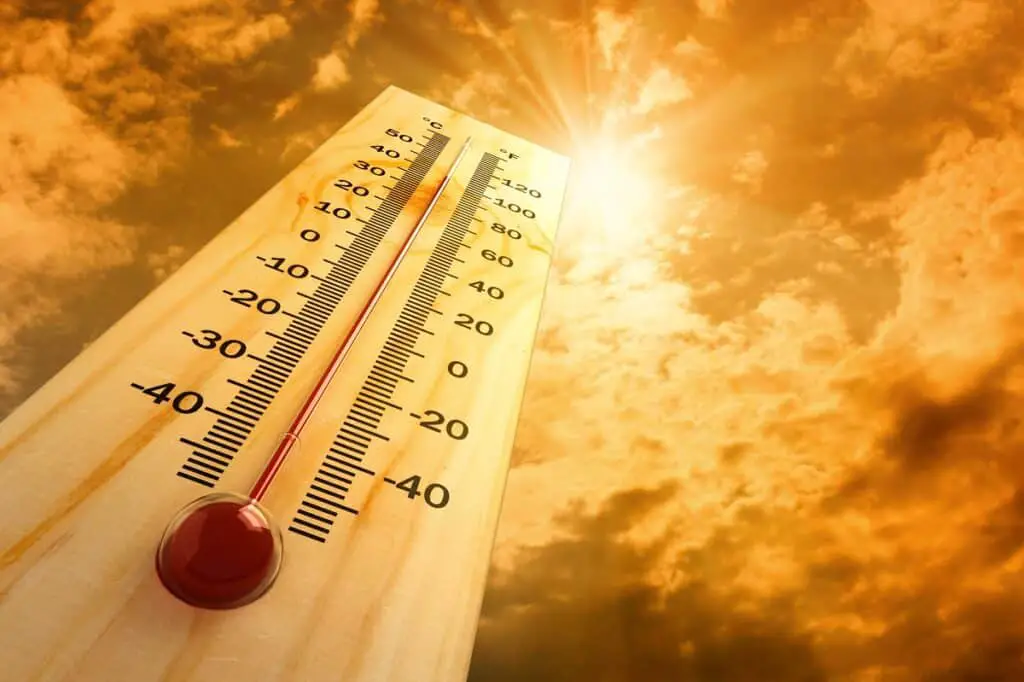With national parks facing record-high temperatures, hikers must arm themselves with these crucial tips to stay cool and safe on the trails. Summer is when you want to spend as much time outside as possible, but heat waves make this difficult. That doesn’t mean you shouldn’t go enjoy a day in nature. You just need to be prepared. If you don’t take precautions while hiking in hot weather, your body may suffer from dehydration, heat exhaustion or even heat stroke.
During our road trip through the deserts of West Texas and New Mexico and was so glad we were prepared for hiking in the hot sun because it was HOT. I also shared with you how several years ago I seriously struggled when hiking in the heat of Bryce Canyon… I thought I was going to die from heat exhaustion. Since then we’ve learned a lot and I’ve discovered a love of desert hikes. It’s all about properly planning and taking your time.
To keep cool, safe and healthy on your next hike in the heat follow these tips that will help you have an enjoyable hike no matter what the day’s temperature is like!
Planning Your Hot Weather Hike
It’s important to plan your hike in hot weather. To do this, you should start by determining where you want to go and when. You’ll also need to know how long your hike will be so you can pack enough water, food and gear. We’ve linked to a lot of additional resources in this article to help you find more information about this important topic. Some of these links may be affiliate links which means we could earn a small commission if you make a purchase.
Best Time to Hike in the Heat
You’d think it goes without saying… but you’d be surprised how often people head out on hikes during the hottest part of the day. And I have to admit that I have found myself in a beautiful place mid-day and taken off on an unplanned hike into the heat because the opportunity was knocking. Sometimes you just have to take advantage of the time you have.
Knowing that the hottest part of the day is 11-3, it is always best to start your summer hiking early in the morning with plans to finish before noon. Or you can start a hike late in the afternoon and enjoy a cooler evening of backpacking.
If you are backpacking multiple days and the heat is intense, think about splitting your hiking day and using your afternoon for a nap or a cooling swim (or why not both).
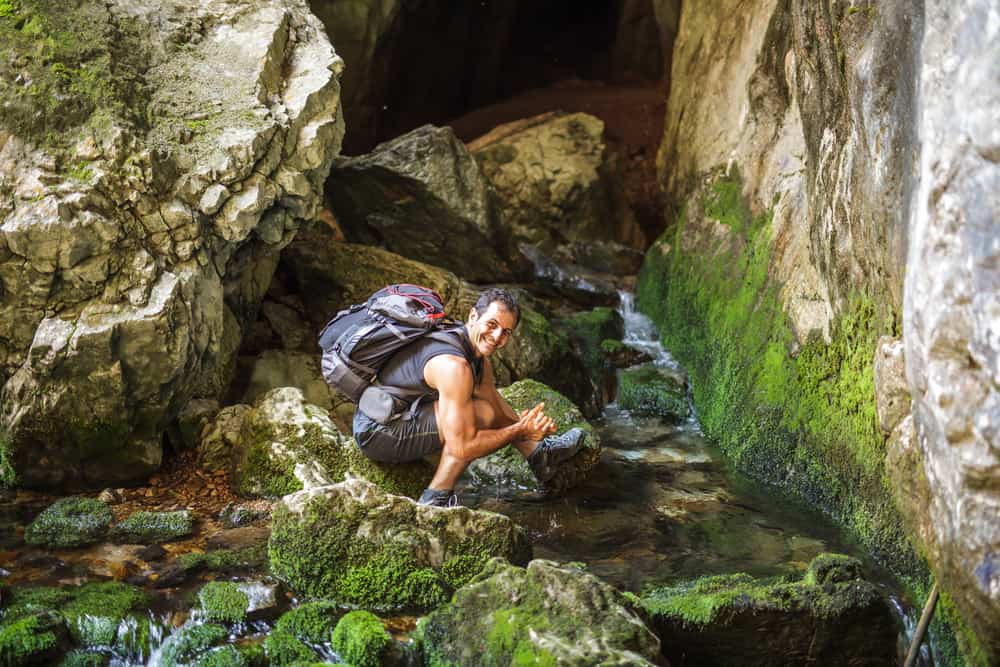
Best Places for Hiking in Summer
Near Water: The safest place to hike when it’s hot is a trail that takes you near water. Choose a trail close to a lake, river or ocean so you can cool off in the water if things get too hot. Freshwater also provides opportunities for emergency water container refills.
Shade: Hiking along shady trails that will help keep you cooler on your hike. You will feel 10-15 degrees cooler in the shade than in the full sun. Just to throw in a little science, did you know that the air is not really cooler in the shade? The difference is you don’t have the solar effect of the sun on your skin raising your internal temperature when you are under the tree canopy.
One more thought on shady trails, if you are hiking in a humid place look for a shaded trail that is more open, with a high canopy. A low, heavy, close tree canopy means no breeze and high humidity which can feel stifling. Not to mention mosquitos tend to thrive in this environment and drive you crazy even mid-day.
Staying Safe and Healthy When Backpacking in the Heat
Let’s talk about the things that can go wrong when hiking in the heat. Not to be a sissy about this, but a heat-related illness can cause disorientation, fainting or even death. Not exactly how you want to spend your vacation… right?
As always, your best defense is a great offense. So here’s a list of what you need to prepare for before you head out on the hot summer trails.
Avoid Sunburns
Sunburn is the simplest thing to avoid. But even the most experienced hiker can get caught off guard. Sunscreen is your best friend, so pack some with you on the trail. Make sure you hit those tender spots like your hair part and ear tips. Hikers often forget their legs, thinking they are out of the “sun zone”. Well, we took just a one-hour hike in Petrified Forest National Park on a blistering day and I ended up with a nasty sunburn on the back of my calves that required me to wear long pants for the next few days of hiking. Not fun!
Dehydration in the Summer Heat
Dehydration is a huge risk for hikers, not only on hot days. If you don’t stay hydrated, you’ll start to feel the symptoms of heat exhaustion and ultimately heat stroke – cramps, nausea, vomiting, weakness… But what does “stay hydrated” mean? It means drink lots of water before you head out on your hike and throughout it. Bring more than you need so you don’t have to worry about it at all. According to Section Hiker you should drink a liter of water for every 2 hours of hiking in moderate weather. So in hot weather, you need to plan for more.
Additionally, you should always carry an emergency backup water purifier just in case you run out of water. You don’t want to drink directly from streams and risk a water-born illness. In our first aid kit that goes on every trip, we have both a simple LifeStraw and water purification tablets. Brad and his son once did an spontaneous 12 mile hike in Glacier NP without adequate water and paid for it with severe cramps that night. It’s not something I’d wish on anyone. If you hike in the heat often or are planning an extended trip then it’s worth the extra weight of a quality water filter.
Can you Overhydrate?
Yes, you can. Drinking too much water is called hyponatremia and it’s a serious condition. It happens because you have diluted the sodium in your bloodstream too much with your water intake. That’s why hikers eat salty snacks on the trail, to keep their electrolytes in balance as they drink and sweat more water than normal due to the heat. The symptoms of hydration and overhydration are similar so if symptoms continue seek medical attention immediately.
Over Heating When Hiking in Hot Weather
Hiking in hot weather isn’t only about being comfortable, heat exhaustion is a real concern. Extreme heat is not my favorite, but because we are very conscientious about being prepared we’ve had many successful hot weather hikes. So I wasn’t ready for the day I severely overheated less than 30 minutes into a hike. Out of nowhere, I became disoriented. It was the scariest moment I’ve ever had on a hike. Luckily we were near a stream and Brad wrapped a soaked shirt around my neck to cool me down (Oh, how I love that guy!).
“Heat illnesses range from mild to severe, and heatstroke can be deadly.”
Cleveland Clinic
The symptoms of over-heating vary. They include fatigue, nausea and a headache. Confusion or anxiety, feeling weak and clammy skin with bumps are common symptoms. Many people also experience muscle aches and cramps. Basically if you start feeling “off” or notice someone in your hiking group struggling you should assume they are over heated and stop to cool down. Don’t take chances by pushing on, take action as soon as you notice any symptoms.
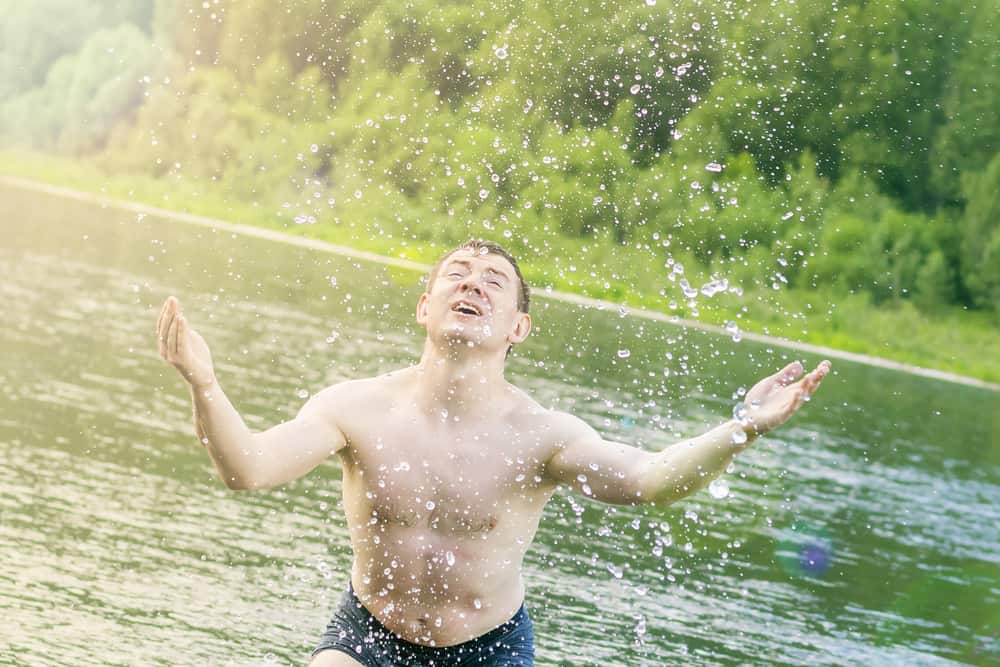
How to Cool Down When You Get Over Heated
You must learn the symptoms of overheating and react before they become severe. Most important is to cool your body quickly when the symptoms start. The fastest way to do this is to find shade and soak yourself with water. Cool compresses on your neck and wrists can also help. If you are near a stream, put your feet into the water.
Extend your break well past when the symptoms subside before you start hiking again. Use that break for a salty snack and to sip water.
If symptoms don’t subside or get worse, seek help. Did you know that over 250 people are rescued out of the Grand Canyon each year primarily for heat-related conditions that become severe? Don’t take chances with your life.

Looking for gift ideas for your favorite Hiker? Check out our Unique Guides!
Hot Weather Hiking Gear You Should Pack
For hot weather backpacking, you just need a few extra supplies in your pack over what you’d normally carry. You can find a complete list of what to pack for day hikes here that covers all types of weather. Here’s our hot weather critical list:
Hydration Bladders and Water Bottles
We often use a combination of a hydration bladder and water bottles when hiking on hot days to ensure we have plenty of water. I like a bladder when carrying a larger quantity of water, say more than a liter, because it places the weight evenly across your back which is much more comfortable than all the weight in the bottom of your pack as you would have with only bottles. Then supplement with individual water bottles to meet (or better yet exceed) the expected amount of water you need. The other advantage of bottles is you can add flavors and electrolytes to just a portion of your water supply.
If your pack did not come with a hydration bladder, check your pack size before purchasing a bladder to make sure it fits well. Check out our complete guide to selecting a daypack if you are looking for one that is hydration compatible.
Emergency Hydration
Imagine something goes wrong and you find yourself needing more water on your hike. It’s quite simple and even very lightweight to add 2 small things to your first aid kit that ensures you can safely drink water you find along the trail.
LifeStraw®– You may have heard of the LifeStraw® before, it’s a personal straw that filters almost any water source down to 0.2 microns! That means you can safely drink from lakes, rivers, puddles or mud puddles without worrying about getting sick. Weighing only 2 ounces, it’s a great thing to have in your pack during hot weather hiking.
Water Purification Tablets– Water purification tablets ensure you can safely drink water in an emergency. They do add an unsatisfying flavor to water so think about adding a flavor packet to the water at the same time. For me, these are my last resort emergency gear because of the flavor.
If you are hiking for an extended time, you’ll want to carry a water filter system with you. They are lightweight and pump water through a filter to refill your bottles or bladder.
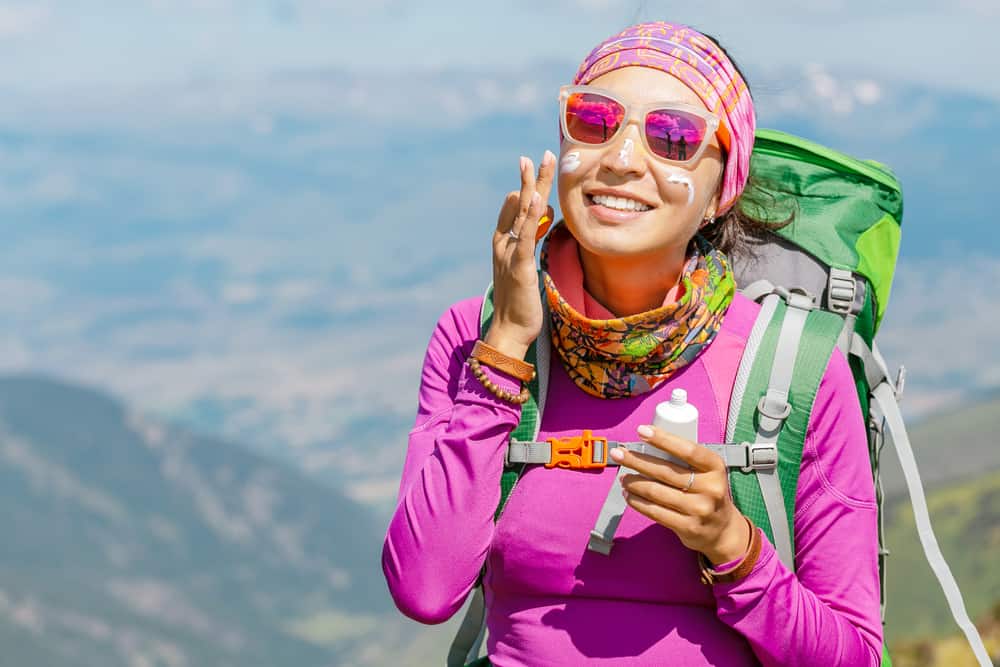
Sunscreen
Not all sunscreens are created equally, and many are not safe for the environment which is especially important if you take a dip in the water. And if it’s hot you’re going to want to do just that! Look for a sunscreen that doesn’t contain oxybenzone and octinoxate like Sun Bum Products. While you are at it, grab a sunscreen lip balm because sunburnt lips are the worst.
Insect Repellent
Insects are not only annoying, but they can also carry disease. The Centers for Disease Control reports that mosquito and tick bites account for over 50,000 cases of infectious diseases such as the West Nile Virus and Lyme disease in the US each year.
During hot weather hiking it’s even more important to protect yourself from these pesky carriers of disease, so bring insect repellent with you when you hike in hot conditions. Look for a small easy to carry bottle of deet free repellent like Sawyer Picaridin Insect Repellent from REI. Check out our guide to Repelling Mosquitoes When Hiking for more ideas to keep these pesky critters at bay.
Tarp to Create Shade When There Isn’t Any
With a simple tarp and your hiking poles (or a couple of long sticks), you can create shade if you find yourself needing a few moments out of the hot sun. We love rain ponchos that can double as a shelter tarp the most since they are lightweight in your pack and heck… that weather just might change to rain.
What to Wear Hiking in Hot Weather
The clothing you wear when hiking in hot weather is just as essential as having enough drinking water. Your choice of clothes can help adjust your body temperature and they can help you stay cooler.
Important Features in Backpacking Clothes for Hot Weather
Here are some of the things to consider in selecting summer hiking clothes:
Clothes Made From Wicking and Quick Drying Fabrics
You will want to stay as cool as possible, and that means you’ll be sweating a lot. You’ll need clothes that help keep the sweat from sticking to your skin by wicking it away from your body. This is called “moisture wicking”. And once the fabric absorbs the moisture you want it to dry quickly. The drying effect keeps you from feeling sticky and also cools as the water evaporates.
Merino Wool and Bamboo are the best fabrics for natural wicking and quick drying characteristics. You’ll also find some modern fabrics that have been designed to breathe and wick away moisture. Make sure you are checking before you buy!
The most important layer for wicking and quick drying fabrics is your underwear. If your panties or bra get soaked you will be miserable and stinky all day long, not to mention you’ll experience chaffing in the worst imaginable places. Yuk. For help in selecting underwear that will keep you cool and dry on a hot summer trail check out one of these guides:
❤ Best Hiking Bras: No More Funky Feeling
❤ Best Men’s Underwear for Hiking: No More Stink and Chaffing
Wear Loose, Breathable Clothing
Loose, breathable clothing helps catch the breeze. They also keep the sweaty fabric from clinging to your skin and holding in your body heat. The best way to cool is to allow your sweat to naturally evaporate.
Choose Light Colors
Light colors like white and pale colors can reflect heat and keep you cooler than dark colors. Dark colors absorb light and heat which would make you hotter.
For tips on how to select the best shorts for hot weather hiking, here are our best guides:
Clothes with Open Vents are Cooler
Venting is common in shirts to allow air to move between your skin and the fabric.
Choose UPF-rated Clothing
Look for clothing made of material that offers protection from the sun’s ultraviolet (UV) rays if it’s a sunny day. For example, lightweight UV blocking shirts with long sleeves help protect your skin from getting burned. As someone who sunburns easily, I love my Columbia PFG shirts for summer wear, as they are lightweight and breathe while protecting me from the hot sun.
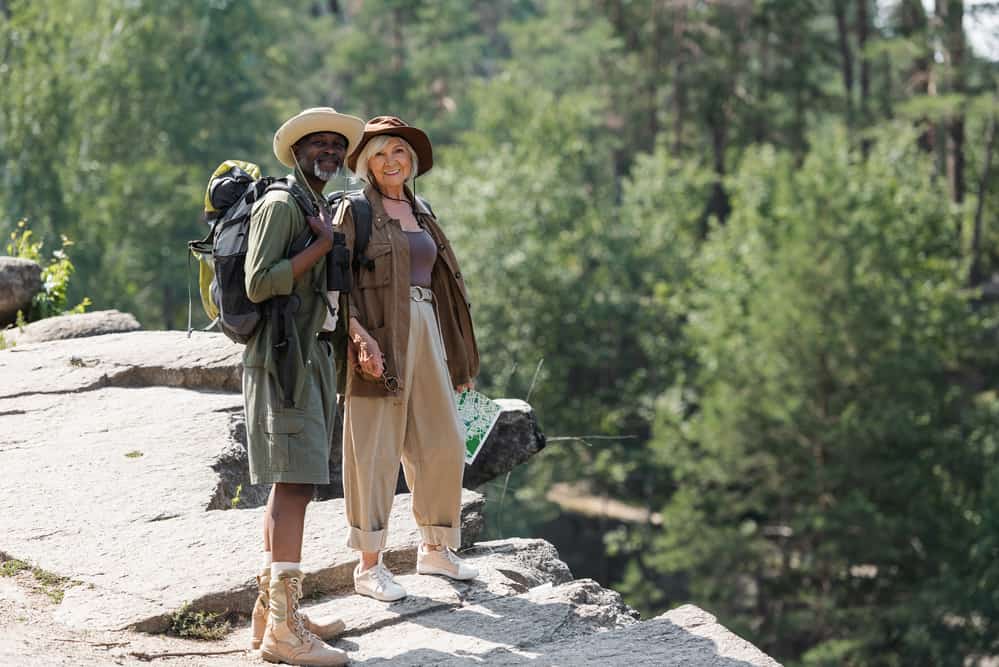
Cover Up with Long Sleeves and Long Pants
While it might seem counterintuitive to wear long sleeves or pants in the heat, many find the protection from the hot sun keeps them cooler than wearing shorts and a tank top.
Wear Protective Head Gear
If the sun is beating down you’ll want to consider a wide-brimmed hat that provides both shade and coverage from the sun. Baseball caps are great for keeping your hair out of your eyes, but they won’t protect your neck and ears. Remember, your head is like a chimney and you lose a lot of heat from your head. So we also like a hat that can be dipped in water and worn wet so the evaporation while hiking cools your head.
The Cotton Controversy
Generally, cotton is never worn when hiking. Although cotton absorbs moisture easily from our skin it doesn’t dry quickly. So when worn hiking it holds moisture against your skin which can cause chaffing where the cotton fabric and your skin rub together. For this reason, you should also avoid wearing denim jeans when hiking since they are cotton.
If temperatures drop while you are hiking, that cotton fabric will also stay wet and chill you. However, in the case of hot weather hiking, there is a cooling benefit to having a piece of fabric on that stays wet. Except… remember you want to avoid chaffing. That means something like a cotton tank top might be a useful cooling device when hiking. But you definitely wouldn’t want a cotton top with sleeves that would rub under your arms or cotton pants that rub between your thighs. You’ll also want that cotton clothing item you choose to wear to be something you only wear during the heat of the day and take off to exchange for something else as temperatures start to cool.
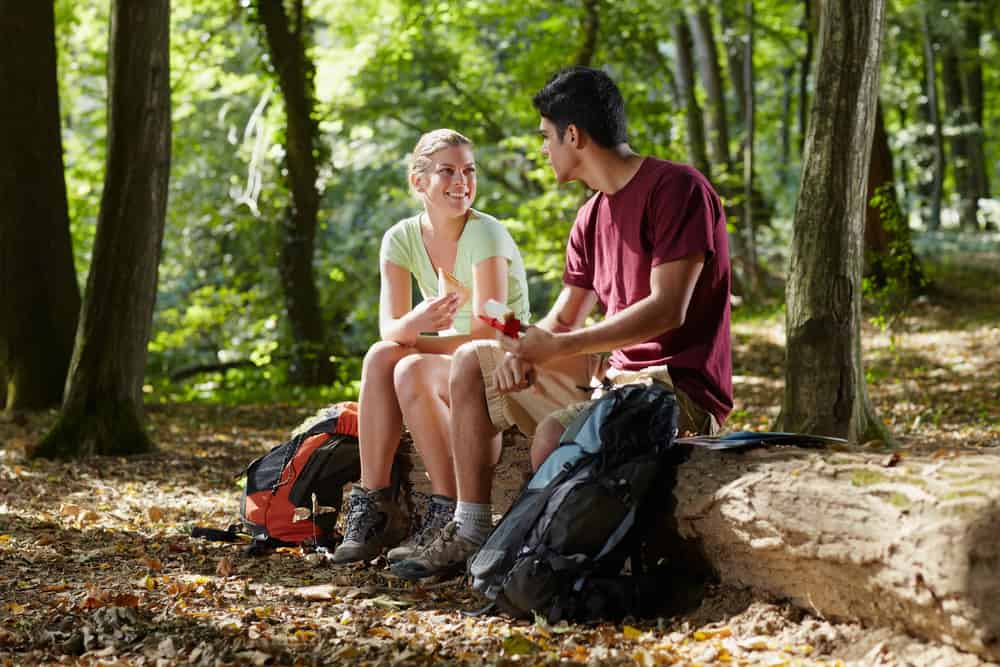
Best Snacks for Hiking in Hot Weather
Hiking in the heat burns more calories than temperature weather because your body is working hard to stay cool. Except heat can also suppress your appetite. That makes it even more important when you are backpacking on a hot day to take snack breaks. Here’s what to look for in the best snacks to munch on a hot hike:
Salty Snacks to Restore Sodium and Potassium
The best granola I’ve ever tasted was during a partial hike into the Grand Canyon. It was indescribably hot that day. And that mix of sweet and salty was the best flavor that no granola since has matched. Not only do salty snacks taste great, they also keep your electrolytes in balance which reduces your risk of over-heating. We like to carry the individual serving packages of nuts and trail mix, like this variety mini pack from Kar’s Nuts, rather than a big bag so we don’t end up with a mess in our backpack. Dried fruit like crunchy banana chips and no sugar added apricots are high in potassium and perfect for your hiking energy.
High Energy Snack
The best snacks for hiking when it’s hot out provide energy and won’t weigh down your pack. That also means if your appetite is gone you’ll be able to grab some needed calories with just a few bites. You should mix proteins for trail stamina and carbohydrates for quick energy. Snack stick, like FireCreek Snacks, deliver a healthy, all-natural protein rich snack while we love the Cliff Mini’s for a healthy energy boost.
Naturally Hydrating Snacks
Did you know an orange is 88% water? And cucumber slices are 95% water? Carrying a few hydrating healthy snacks like these will do double or even triple duty in filling your lunch bag with nutrients to combat the heat and keep you hydrated.
Other Tips for Hot Weather Hiking
Before you go, here are just a few more things to think about when preparing for your hot weather hike.
Check the Weather Forecast
High temperatures often coexist with incoming storm fronts. Make sure you check the weather reports before heading out on a hot day. Lightning storms and flash floods can create a dangerous situation.
Don’t Push Yourself
Even if it’s scorching outside, hiking is supposed to be enjoyable. So don’t feel obligated to go at a fast clip. It’s fine to walk more slowly to stay cooler. As a result, you will enjoy your trek more
Take more rest breaks than usual. Rest breaks encourage you to drink water and eat food, both of which are required by your body to keep safe in hot weather.
Take Care of Your Feet
Blisters are much more likely in the heat when your shoes and socks are more likely to get soaked with sweat. The right socks that wick away sweat make a big difference. My favorite hot weather socks are Smartwool’s Performance Hike Light, made of moisture wicking merino wool. And carrying an extra pair of dry socks should be on the top of your essentials list! Changing socks mid-hike will make you feel like a new person.
Hike With a Buddy
Anytime you are hiking in a risky environment, a hiking buddy is your first line of defense if you do have problems.
When NOT to go Hiking in the Heat
- If you have a chronic condition, are pregnant or have recently had surgery, it’s best not to hike in the heat.
- Heat is known to amplify meds so be cautious when hiking if you are on medication, especially if it’s a new medication that you are not experienced with how it affects you.
Hiking with Children In The Heat
Consider the specific needs of your children when hiking on a hot day. Children don’t sweat as easily as adults which makes their natural cooling mechanism work less efficiently. So ensure there are lots of cooling opportunities for kids. What kid doesn’t love splashing in a stream? But a day of climbing over sunny rocks might just push them over the edge both physically and emotionally. I don’t know about you, but the last person I want to be hiking with is a grumpy child.
Just as your appetite is suppressed when it’s hot, kids will also have less desire to eat and drink. The difference is you know you must do both even if you don’t feel like it, while kids don’t. Monitor that your child is taking in enough water and nutrients. Packing snacks that are extra tempting to kids will help encourage your kids to eat. Here’s our full list of tips for hiking with children.
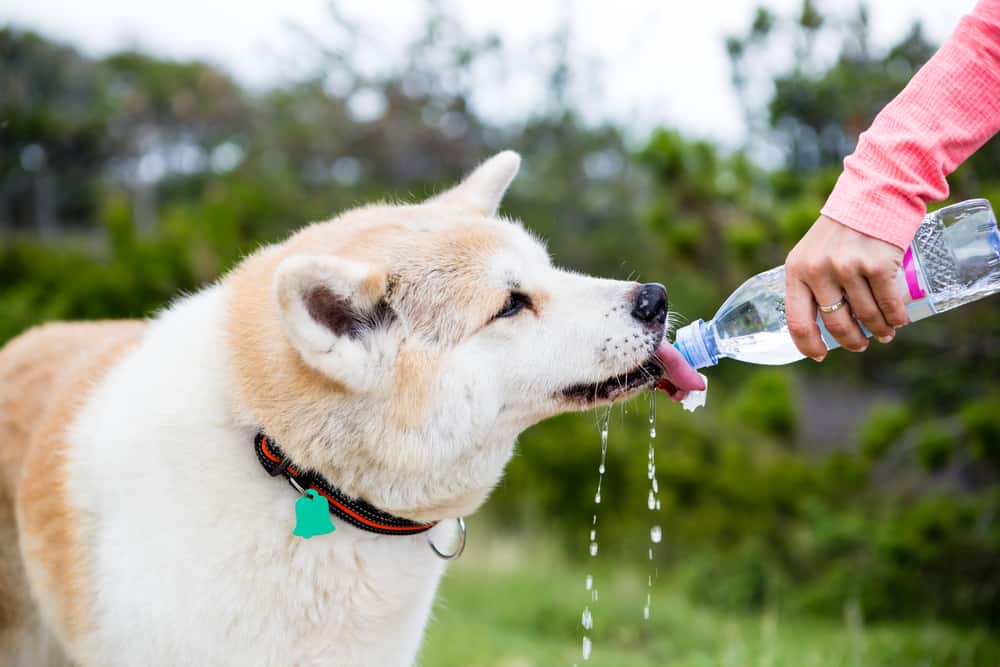
Hiking with Dogs When It’s Hot
I’d like to just say don’t do it. Don’t take your dog on a hike when it’s super hot. A short walk to splash in a creek? Sounds great. Anything longer please think hard about taking your best friend along.
“Dogs can suffer fatal heatstroke within minutes.”
Blue Cross for Dogs
Imagine that you are hiking in full sun on a 100-degree day in your winter parka. That’s how your fur baby feels. Unlike humans, dogs don’t sweat through their skin, therefore they rely on panting and releasing heat through their paw pads and nose to regulate their body temperature. The surface area is much less than for you so they can struggle to cool off when overheated.
Hiking in the heat can be tough on your body, but it’s important to take precautions. We’ve provided some tips for how you can stay safe and comfortable during a hike in hot weather so that you don’t get dehydrated or experience more serious health conditions from over-heating. Closing with wishes of safe hiking for you and your family.
For more tips for Hot Weather Adventures, check out our Tips for Camping in the Desert: Camp in the Heat Like a Pro.
